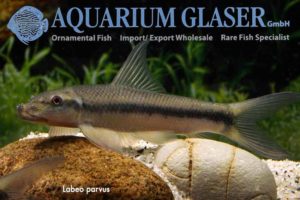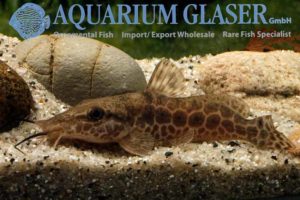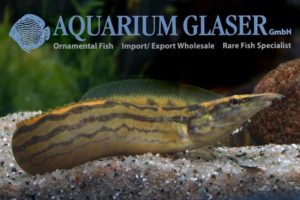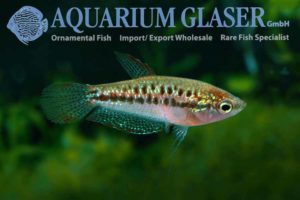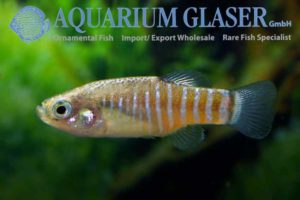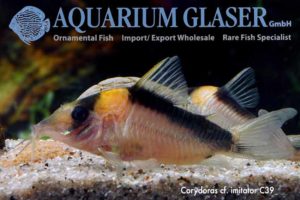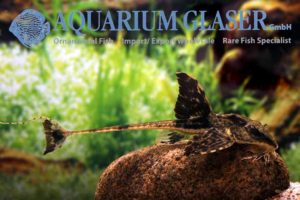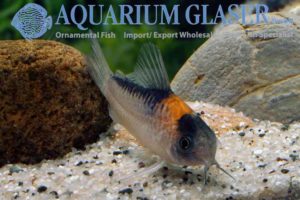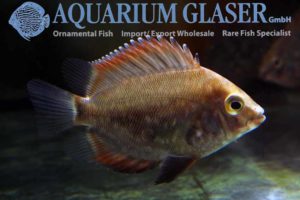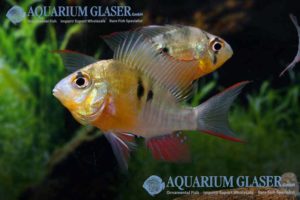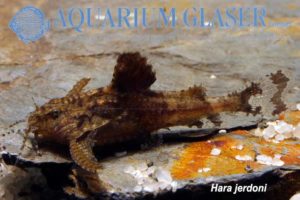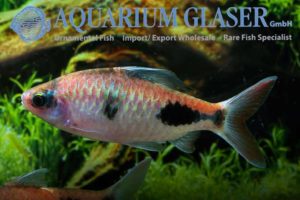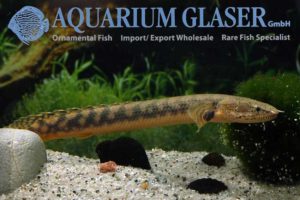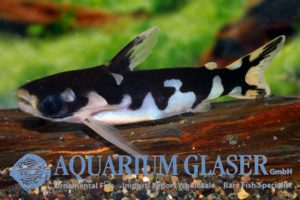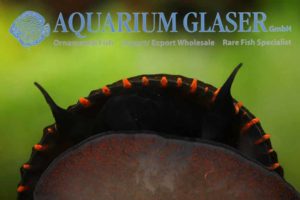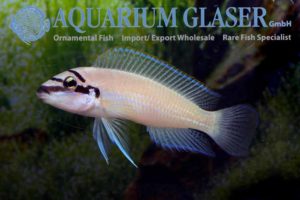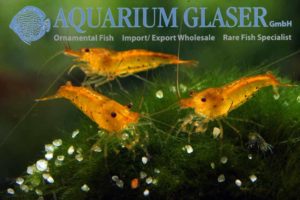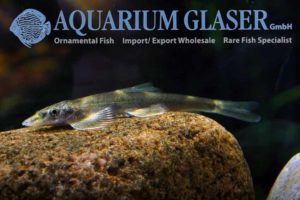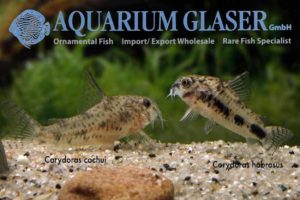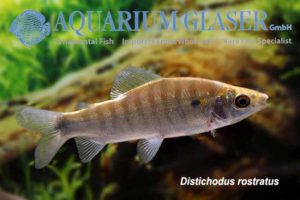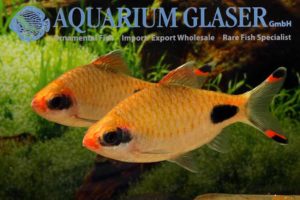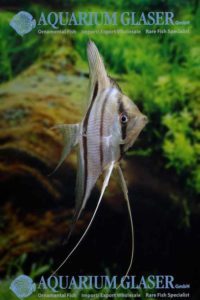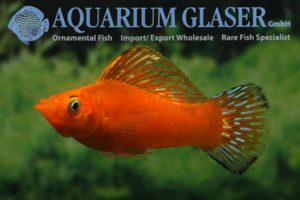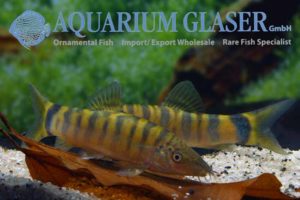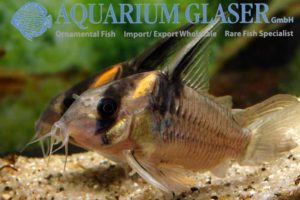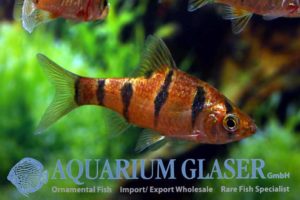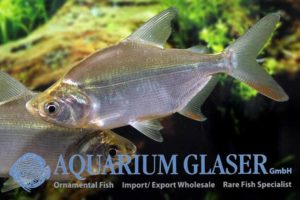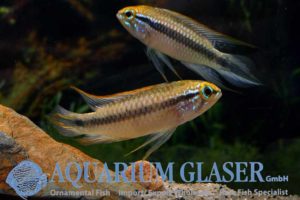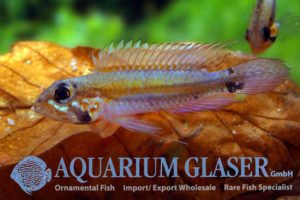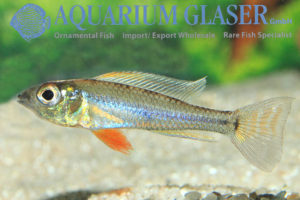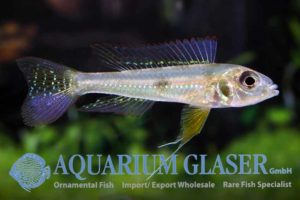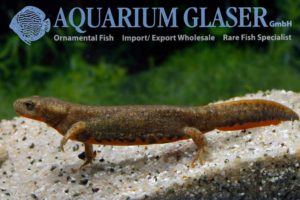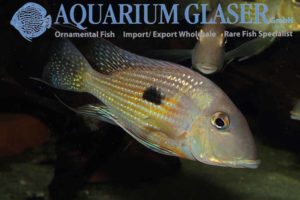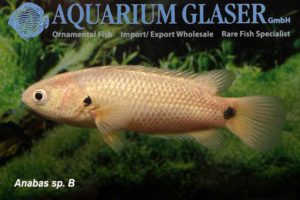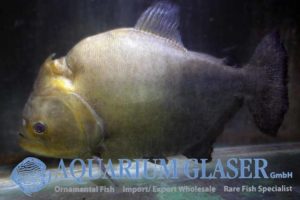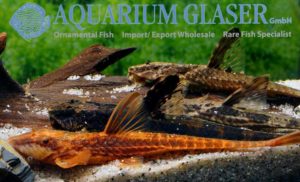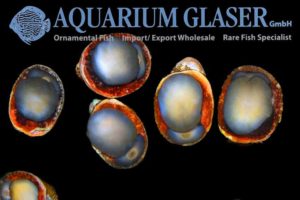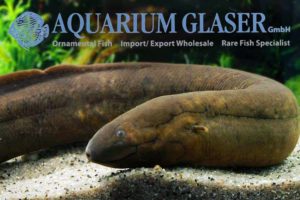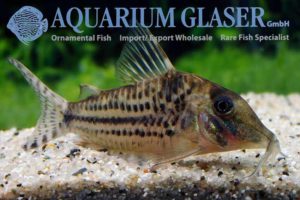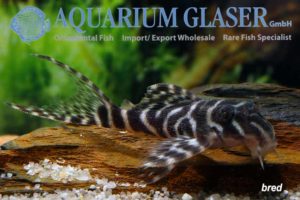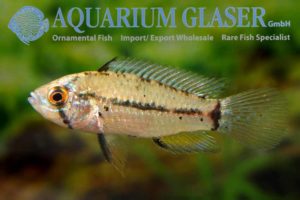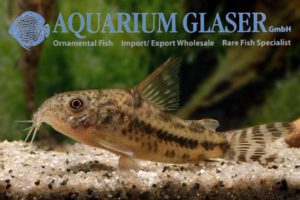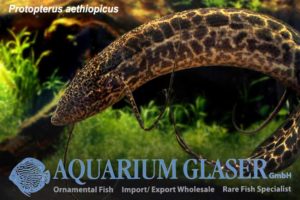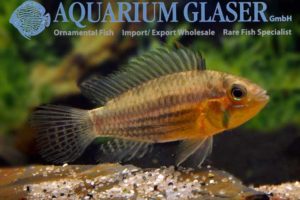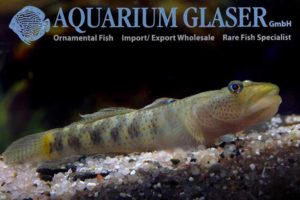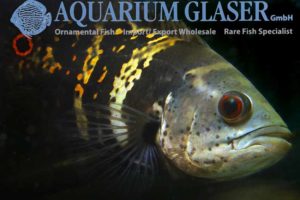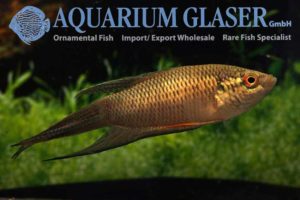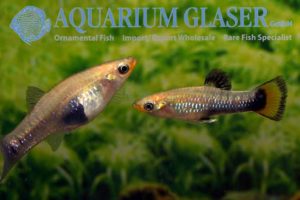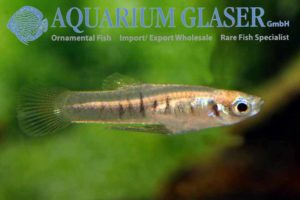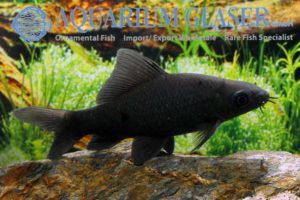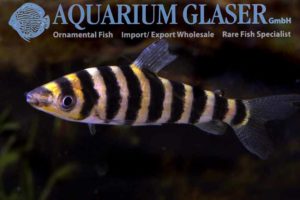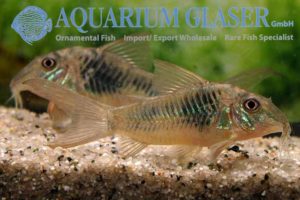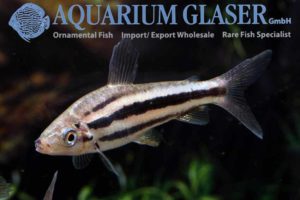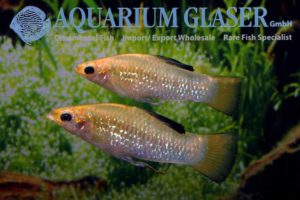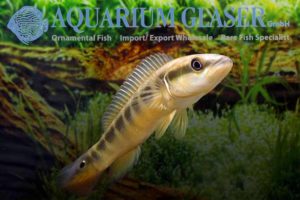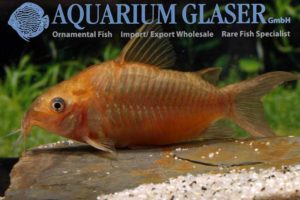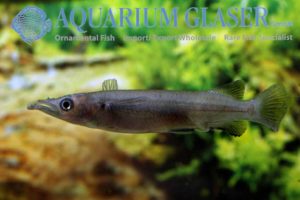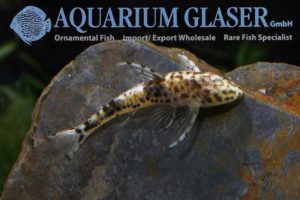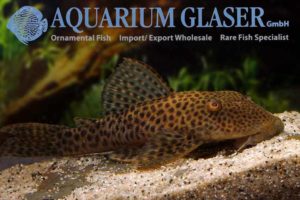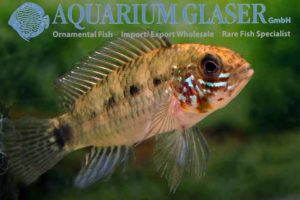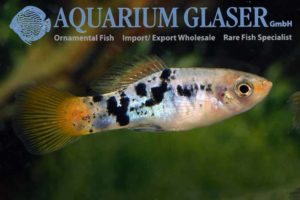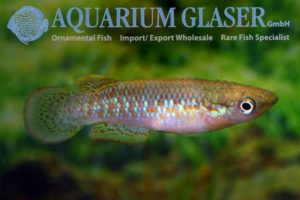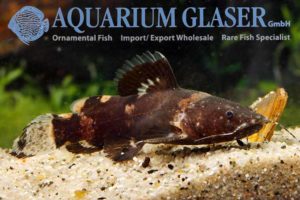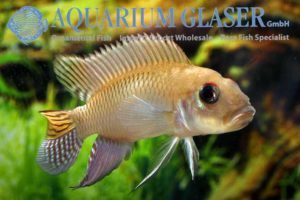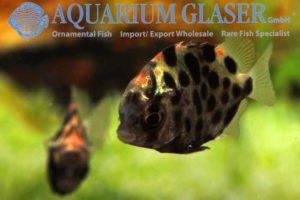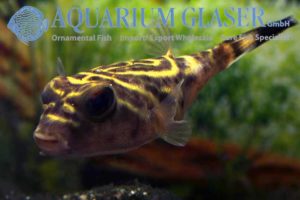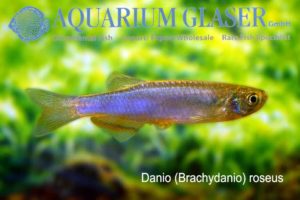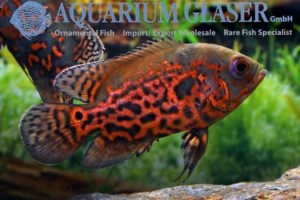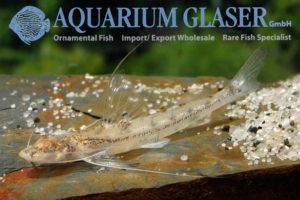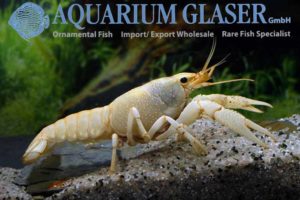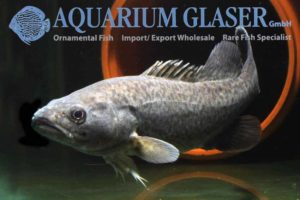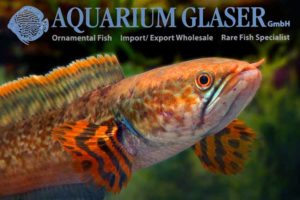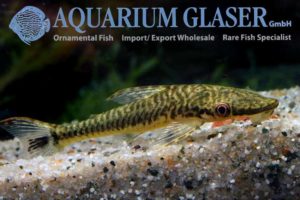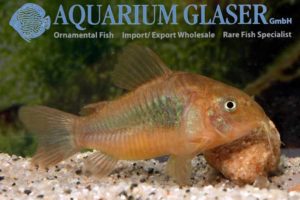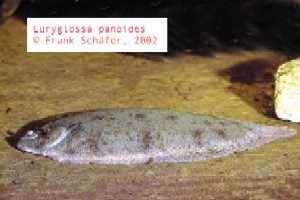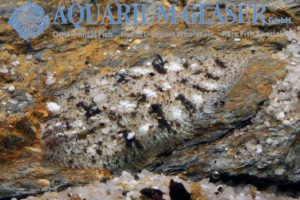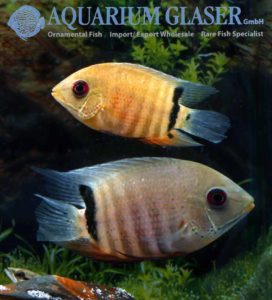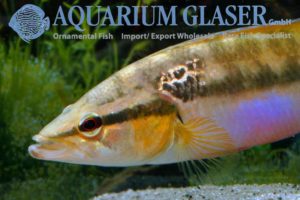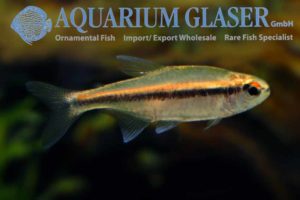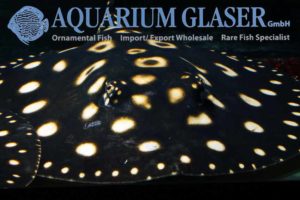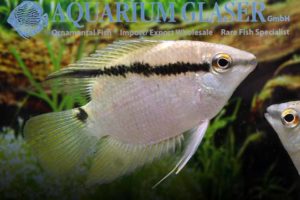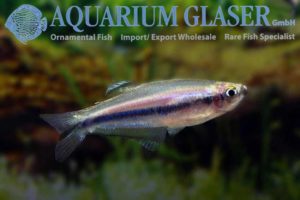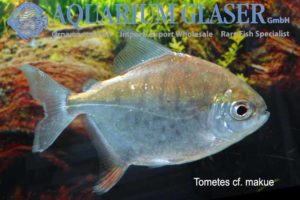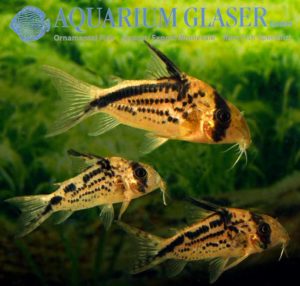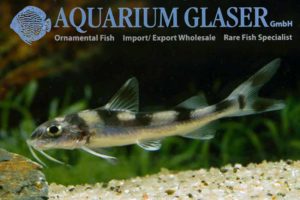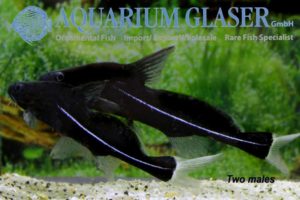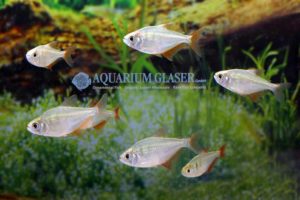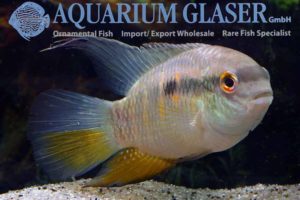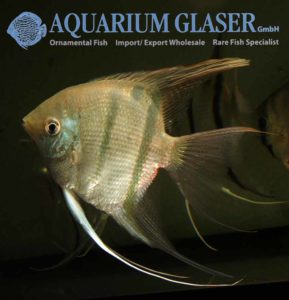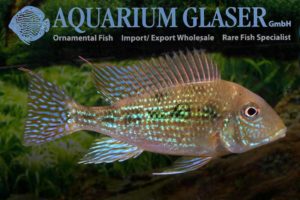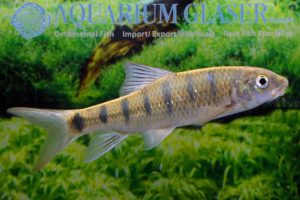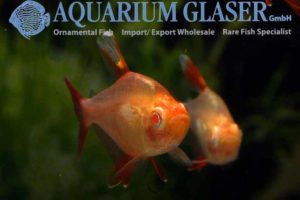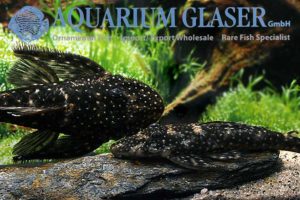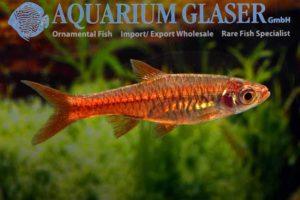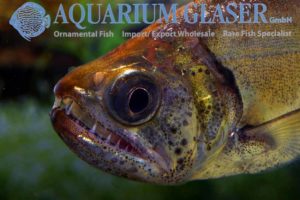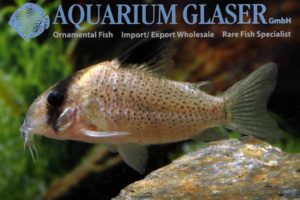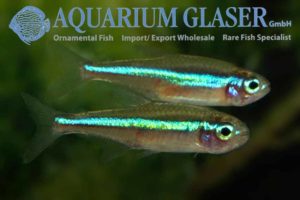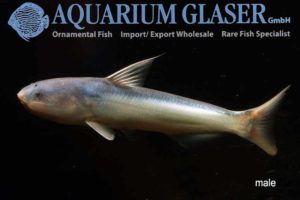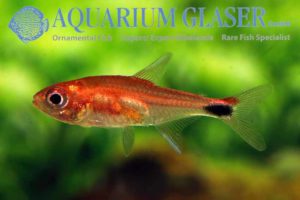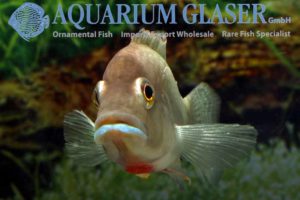Algae eaters from Africa? Hardly ever are such fish available in the trade, despite the fact that there does a high number of species exist. Currently we have two species of African Labeo in stock. There is no doubt that Labeo parvus is the better algae eater of the two. It looks astonishing similar to […]
Fish Archive (3109)
-
-
Auchenoglanis wittei
Until recently only two species of Auchenoglanis were commonly accepted, namely A. biscutatus and A. occidentalis. This changed with the revision of Retzer (2010), who recognizes eight different species. In the Congo the genus is represented by Auchenoglanis wittei, which can be easily identified by the “reticulated giraffe”-pattern of the body. However, this is the […]
-
Mastacembelus tinwini
Sadly we can offer this beautiful species of spiny eel only very rarely. The species has been described scientifically quite recently. It is a close relative of the common spiny eel of Asia, Mastacembelus armatus. Like that species, M. tinwini reaches a length of about 40 cm. Other fish are ignored if they are large […]
-
Trichopsis pumila
The Sparkling Gourami (Trichopsis pumila) is one of the smallest species of anabantoid at all – and one of the prettiest! The charming and totally peaceful species attains a maximum length of only 3-4 cm and is perfectly suitable for an community tank with other tiny, peaceful species of fish. The tank should be well […]
-
Aphanius farsicus
Currently we have some fish in stock that are available every year only for a few weeks. These species are kept and bred by the hobbyists in a very special way, the “balcony aquarium hobby”. The species kept in that manner are specialized in water temperatures that differ clearly between day and night and they […]
-
Corydoras imitator and C39
Currently we receive imports of “Corydoras imitator” from the upper Rio Negro in Brazil. If one takes a close look on the fish it becomes obvious that hardly two specimens look really identical. Coloration is variable, as well is the shape of the body. Some fish, for sure, are unplanned by-catches, for example C. incolicana […]
-
Loricaria sp. Rio Atabapo
Finally we are able again to offer bred specimens of this Loricaria. It is the most beautiful species of the genus. Like all its relatives it is a mouthbrooding species. The males carry the egg-clusters along with them. For this they use the lower lip, which becomes much bigger during the breeding season, until the […]
-
Corydoras njisseni
Finally we were able to import again the smallest and cutest of all the different “orange blotch” Corydoras from the Rio Negro: Corydoras nijsseni. This fish is a close relative of C. elegans. The coloration, which is the same in Corydoras adolfoi, C. duplicareus, C. imitator, C. sp. C39, C. serratus, and serveral other species, […]
-
Uaru amphiacanthoides, bred
Only very view species of cichlid have such a drastic change of coloration during growing like Uaru amphiacanthoides. We can offer currently very nice bred ones. Uaru are close relatives of the discus. Like discus they wear the dorsal fin almost always spread. However, Uaru are mainly vegetarians. For more information and pictures of adult […]
-
Mikrogeophagus altispinosus
The Bolivian Ram, Mikrogeophagus altispinosus, is by far less popular than its well known cousin from Venezuela, the Common Ram (M. ramirezi). Maybe this is due to the fact that the Bolivian is traded almost exclusively as bred ones, because there are no commercial exports from the area where the species occurs naturally? But the […]
-
Hara jerdoni
Currently is the high season for the interesting moth cats (Hara). These catfish occur in India, Burma, and Thailand. The species are very difficult to tell apart, in many cases it is simply impossible in live animals. There are a few species that can be determined by a filament on the caudal fin, but most […]
-
Dawkinsia cf. exclamatio
We were able to import another splendid large barb from India. It belongs to the species Dawkinsia (formerly Puntius or Barbus) exclamatio or a closely related, scientifically still undescribed species. The fish are currently 8-9 cm long and are in breeding condition. Both sexes show now a red back, the males also develop “spawning pimples” […]
-
Polypterus retropinnis
After quite a long time we were able now to import again one of the smallest species of Polypterus, namely Polypterus retropinnis from the Congo. This bichir has been thought to represent an undescribed species for a while, but then it was found that it has been confused with the only recently described species Polypterus […]
-
Tatia musaica (= Cenromochlus orca)
We were able to import again a small number of the most attractive of all driftwood-catfishes: Tatia musaica, the ninja-tatia. This beautiful fish attains a maximum length of about 5-6 cm. Like all the driftwood catfishes this species also has an internal fertilization. The male´s anal fin is modified for that purpose, similar as it […]
-
Paludomus loricatus
Among the most unusual species of freshwater snail is the Red Spotted Bella Snail, Paludomus loricatus, from Sri Lanka. The eyes of this snail are very attractive coloured, brightly red-orange. Around the mantle are numerous folds of the same colour. We are informed on the biology of P. loricatus by Starmühlner (Starmühlner, F. (1974): The […]
-
Chalinochromis brichardi
This pretty cichlid from Lake Tanganyika is only very, very occasionally found in the trade. This is hard to understand. Despite the fact that the coloration is rather simple, the fish are quite conspicuous. Keeping and breeding can be compared with the closely related genus Julidochromis. Maximum size of Chalinochromis brichardi is about 12 cm. […]
-
Neocaridina sp. Golden Tiger
This is the latest star in our stocklist: are real pretty little creature! The animals are German bred ones, available in very limited numbers only! For our customers: the shrimps have code 485472 on our stocklist. Please note that we exclusively supply the wholesale trade. Text & photos: Frank Schäfer
-
Pseudohomaloptera sp – A new dwarfish hillstream loach from Vietnam
For the first time ever we obtained this hillstream loach from Vietnam. The determination is pretty tricky. All features visible in live fish (position of the dorsal fin, coloration, position of the anus) lead to the genus Pseudohomaloptera, which currently includes six described species: Pseudohomaloptera tatereganii (Popta 1905), P. sexmaculata (Fowler 1934), P. leonardi (Hora […]
-
Corydoras cochui and C. habrosus
These dwarf species of Corydoras have been confused quite a long time. Both species attain a maximum length of about 3 cm and a very cute, nice and lively aquarium fish. If one has the opportunity to see live specimens of both species together it may be hard to understand how they may be confused; […]
-
Distichodus rostratus, D. engycephalus and D. brevipinnis from Nigeria
Last week we received for the first time an unsusal shipment containing Distichodus unknown to us from Nigeria. The first determination was that they belonged to the species Distichodus rostratus. This species attains a maximum length of about 70 cm. We thought initially that all or fish would belong to the very same species, despite […]
-
Dawkinsia assimilis
In South India a group of barbs exists that was formerly placed either in Barbus or in Puntius and which is now placed in the only recently (2012) erected genus Dawkinsia. In Dawkinsia a phenomenon exists that aquarists are used to know for example from cichlids from Lake Malawi: every new collecting site reveals a […]
-
Pterophyllum scalare WILD Rio Xingu
We received very nice wild collected angels from the Rio Xingu in Brazil. The animals are “real” P. scalare with pointed snouts. They will most probably grow up to impressive, large fish. For our customers: the fish have code 699853 on our stocklist. Please note that we exclusively supply the wholesale trade. Available in limited […]
-
Poecilia velifera NEON ORANGE
We received this new sport of Molly from Southeast Asia. It was offered under the name of “Neon Orange”. The special feature of the new sport is the reflecting border of the scales on the back in front of the dorsal fin. This is more obvious in females than in males. In males. the reflecting […]
-
Yasuhikotakia sp New Cambodian Tiger
Formerly all the deep bodies loaches from Indochina were placed in the catch-all genus Botia. This generic name should be used now only for the Indian species, while the species from Laos, Thailand, Cambodia, and Vietnam are placed in Ambastia, Syncrossus, and Yasuhikotakia. We now were able to import for the first time ever a […]
-
Corydoras CW 45 Lessex
We can currently offer a very limited number of a new variety of the rare species CW 45. The fish was named “Lessex” by the exporter. We adopted that name, but we don´t know the meaning. CW 45 is a deep bodied species, similar to C. armatus. It differs from the latter by the bright […]
-
Desmopuntius hexazona wild
The banded barbs from Southeast Asia were always matters of interest, both of aquarists and scientists. The generic position of the species was unclear for quite a long time: they were placed in Barbus, Puntius, or Systomus. But t seems that the problems has been solved finally. The elongated species are now placed in the […]
-
Citharinus citharus
We recieved Moonfish, Citharinus citharus, from Nigeria. This tetra is only very rarely available. The large species can attain a maximum length of about 60 cm and 7 kg of weight. In its home countries, the moonfish is a much estimated food fish. But the species is also very interesting in respect of aquarium keeping. […]
-
Apistogramma agassizii Tefé II and A. geisleri
We received very nice wild ciollected specimens of this variety of A. agassizii. One must not confuse these fish with the variety known as “Tefé I” (see http://www.aquariumglaser.de/en/fish-archive/dwarfcichlids-en/Apistogramma_agassizii_Tefe_en/), which is distinguished from all other varieties of A. agassizii by the additional rows of zigzag-bands on the belly. The variety “Tefé II” is characterized by a […]
-
Apistogramma diplotaenia
This dwarf cichlid is one of the most unusual members of the large genus Apistogramma. The very slim animals have a pattern of two longitudinal stripes. This is unique among Apistogramma and makes A. diplotaenia unmistakable. Sadly this species is offered only very rarely. Currently we have both wild collected fish (see photos) and bred […]
-
Biotoecus opercularis
This fish probably represents the most interesting species of dwarf cichlids from Amazonia. Currently we were able to import it once more. B.opercularis is for sure not demanded due to its coloration. As typical sand cichlids they do not have pop-art colours, but shining pastel shades. The same phenomenon can be found in the sand […]
-
Biotoecus opercularis
We received beautiful, fully grown wild collected Biotoecus opercularis from Brazil. Formerly these sandhill-builders (see http://www.aquariumglaser.de/en/fish-archive/dwarfcichlids-en/biotoecus-opercularis-3/) were said to be extremely demanding and difficult to keep. Our recent imports, however, are very, very stout and healthy animals! For our customers: the fish have code 634493 on our stocklist. Please note that we exclusively supply the […]
-
Cynops cf. cyanurus
The fire bellied newts of the genus Cynops are perfect aquarium newts. Most specimens can be easily adapted for a life in water the whole year through. This makes feeding a lot easier, because on land newts are very secretive and feed only on live food, while in the water they also readily accept frozen […]
-
Geophagus sp. Aporema
Aquarium Glaser obtained in spring 2014 a boxed that contained a mixed group of Geophagus, which belonged to three different species. Among them were seven specimens that could not be applied to any known species of Geophagus so far. The fish were 7-8 cm long. Over the time the grew up to gorgeous, about 20 […]
-
Anabas
Fishes of the family Anabantidae are often referred to as Climbing perches. This name bases on a species of fish that is very famous among mankind, even in people who are not much interested in fish at all: Anabas testudineus. The species is known to walk over land at wet weather to search for new […]
-
Serrasalmus rhombeus – veteran
From time to time we import fully grown Black Piranhas from Peru (see http://www.aquariumglaser.de/en/news/3500gramm_35cm_Serrasalmus_rhombeus_BLACK_en/). Serrasalmus rhombeus (formerly also known as S. niger) is the biggest of all species of piranha. In contrast to the well known Red Piranha (Pygocentrus nattereri) the Black ones are solitary fish. The specimen we obtained now shows clearly how hard […]
-
Rineloricaria lanceolata
Currently we obtain very nice Rineloricaria lanceolata from Paraguay. This species of whiptail catfish is very variable in respect of coloration. Almost all colours from deep dark brown (almost black) to a light clay-brown can be observed. It was back in the 1980ies that a brick-red sport of whiptail catfish appeared in the former GDR. […]
-
Neritina violacea, Red Lip Snail – new in stock
The snails of the genus Neritina have become very popular among aquarists. These snails are excellent algae eaters. They feed most algae from the glasses of the tank, because they prefer hard surfaces to live on. Another advantage of these snails is that they cannot breed under aquarium conditions, because the larvae develop in marine […]
-
Lepidosiren paradoxus
Only recently we introduced to you our lungfishes imported from the Congo (http://www.aquariumglaser.de/en/news/protocheirodon-pi/). Now we received the even rarer cousin: the South American Lungfish, Lepidosiren paradoxus, from Paraguay. There is only one species extant in South America, namely this living fossil. We usually import them as small young fish from Peru, the specimens we now […]
-
Corydoras vittatus
And here we have one more beautiful species of currently imported Corydoras. Corydoras vittatus – the specific name means “striped” – is one of the most variable species in respect of the individual pattern. The fish originates from Brazil. Formerly it was often regarded to be a subspecies of the also very variable species Corydoras […]
-
Hypancistrus sp. L66 King Tiger Pleco
The King Tiger Pleco originates from the Rio Xingu in Brazil. The species belongs to the most popular plecos in the hobby. This fish attains a length of about 15 cm. Currently we can offer very nice German bred ones (4-5 cm long), which have a pretty and strongly contrasting black-and-white-pattern. Like in all species […]
-
Apistogrammoides pucallpaensis
Among the dwarfs this is the smallest: Apistogrammoides pucallpaensis. This species from Peru is one of the smallest species of cichlid at all. The maximum size is given in literature with 5 cm (males) and 4 cm (females). However, this must refer to very old aquarium specimens. Wild collected ones are mature and fully grown […]
-
Corydoras diphyes and Otocinclus mimulus
Corydoras diphyes and Otocinclus mimulus are available irregularly in Germany and have been recently described by Axenrot and Kullander (2003). They originate from the tributary of the Rio Monday, a river flowing into the Rio Parana in Paraguay. This species was known, for quite a long time, as Corydoras flaveolus in the hobby; this species, […]
-
Lungfishes from the Congo
After quite a long time we were able again to import juvenile lungfishes from the Congo. Currently the animals are 12-20 cm long. Three species of lungfish are known to occur in the Congo: Protopterus aethiopicus, P. annctens, and P. dolloi. At least two of them, namely P. aethiopicus and P. dolloi are represented in […]
-
Apistogramma cacatuoides wild
The Cockatoo Dwarf Cichlid is one of the most popular members of the genus Apistogramma and found in petshops all over the World. Almost exclusively bred specimens of very colourful sports are traded. These do not appear in the wild. However, “the” wild form of A. cacatuoides does not exist at all. Like so many […]
-
Rhinogobius maculafasciatus
Once more we are able to offer a species of freshwater goby that was not imported so far to Europe: Rhinogobius maculafasciatus. The species has been described scientifically only in 1996 from Taiwan; our specimens originate from Taiwan. So we are comparatively sure that the determination is correct. Determination of a Rhinogobius is not that […]
-
Astronotus zebra Tapajos
Again we were able to import a small number of this splendid wild form of the Oscar. For more informations, please see http://www.aquariumglaser.de/en/fish-archive/southamerican-cichlids-en/Large_wild_collected_Zebra_Oscars_arrived__en/ For our customers: the fish have code 633426 on our stocklist. Please note that we exclusively supply the wholesale trade. Available in very limited numbers only! Text & photos: Frank Schäfer
-
Macropodus spechti
The ancient homeland of the Black Paradise Fish (Macropodus spechti, formerly M. concolor) is Vietnam. We obtained now fully grown, wonderful specimens from there. The fish are most probably bred ones, but they differ clearly from the strain bred in Europe since the 1930ies. In direct comparison the new importations show a very attractive, brass […]
-
Poecilia (Limia) melanogaster
It happens only rarely that a wild form of livebearer is kept continuously over decades by hobbyists. This is understandable if one takes a look on the immense number of colourful sports that do exist from guppy, platy, molly & co.. So, if a wild form is able to compete with them it is without […]
-
Scolichthys iota
For the first time ever we are able to offer this tiny species of livebearer. Scolichthys iota has been discovered and described back in 1967 already, but has become never known alive to hobbyists until very recently. Our specimens are German bred. Males attain a maximum length of only 1.5 cm, females get almost double […]
-
Labeo chrysophekadion
The black shark is of course no shark at all, but a cyprinid or carp. It is a very large growing species, attaining almost a metre in length and 7 kg in weight. Like many other large carps it is a very much sought for food fish in Southeast Asia. So it is bred in […]
-
Unusual ornamental fish bred in Indonesia 3: Leporinus affinis
This is another, very attractive large tetra, which is currently offered as bred specimens from Indonesia. This Leporinus attains a maximum length of about 25 cm total length and stays a bit smaller than the otherwise very similar L. fasciatus, which reaches about 30 cm total length. The species needs a lot of plant material […]
-
Unusual ornamental fish bred in Indonesia 2: Corydoras septentrionalis
Corydoras septentrionalis is rather rare in the trade. It occurs in Venezuela and Colombia. The species is very similar to Corydoras ellisae from Paraguay. It differs from C. ellisae mainly due to the much longer snout and the colourless fin (with a spotted pattern in C. ellisae). We were a bit surprised to obtain that […]
-
Unusual ornamental fish bred in Indonesia 1: Leporinus arcus
There are many very successful breeders of ornamental fish in Indonesia. These people are able to breed even species that have proven to be unbreedable in hobbyists tanks for decades already. However, not all the species that are used as ornamental fish are only ornamental. Many species, for example Colossoma macropomum (Giant Pacu), the species […]
-
Poecilia (Limia) perugiae
The Dominican Republic is the destination for millions of tourists each year. But it is only known by few people that also beautiful freshwater fish exist there. One of the prettiest of them is Poecilia perugiae. We can offer this beautiful livebearer on a quite regular basis, but have usually only few specimens in stock. […]
-
Crenicichla semifasciata
Formerly the pike cichlids were splitted in two genera. Batrachops and Crenicichla. Batrachops were the rather blunt-headed species. Nowadays this classification is not accepted anymore and Batraochops seen only as a synonym of Crenicichla. However, hobbyists have not forgotten the old name… One of these blunt headed species is Crenicichla semifasciata from Paraguay. The attractive […]
-
Corydoras pantanalensis C5
This species is one of the largest of its genus: C. pantanalensis can reach a total length of more than 8 cm! Now we finally were able once more to import these splendid pieces of gold in small numbers. Besides the impressive size Corydoras pantanalensis is also very interesting because the males develop during the […]
-
Nomorhamphus celebensis
Most of halfbeaks of the genus Nomorhamphus originate from Sulawesi (formerly known as Celebes). Some species, like N. ebrardtii or N. rex, are traded usually as wild collected ones, others, among them N. liemi, are occasionally also available as bred ones. A species that occurs hardly ever in the trade is the Black Halfbeak, Nomorhamphus […]
-
Parotocinclus cf. variola
For the first time ever we were able to import this interesting dwarf suckermouth catfish. It originates from a only recently discovered region, namely the waterfalls of Cachoeira do el Dorado in the far northern parts of Brazil, almost at the border to Venezuela. This area has not been explored ichthyologically yet. Of all the […]
-
Hypostomus sp. LDA10
The great rush for l-numbers is over, no doubt. But even at the highest level of the hype some of the species appeared only once or twice in the ornamental fish market. One of those guys is LDA, a species of Hypostomus with an extraordinary broad head. Obviously this species lives syntopically with the much […]
-
Apistogramma commbrae
The species Apistogramma commbrae is only very occasionally available. The species has been described back in 1906 already and has a very wide distribution: Argentina, Brazil, and Paraguay. But from this region mainly the close relatives of A. commbrae, namely A. borellii and A. trifasciata become exported. This is not easy to understand, because A. […]
-
Xiphophorus variatus Rio Nautla
We obtained in very limited numbers this beautiful local variety of the wild variatus platy (Xiphophorus variatus) from a German breeder. The Rio Nautla variety is a fish that occurs in the wild, not an artificial sport! For our customers: the fish have code 442983 on our stocklist. Please note that we exclusively supply the […]
-
Pachypanchax playfairii
Aquarists who like to read in elder books find this killifish in all literature until the 1970ies: the Golden Panchax, Pachypanchax playfairii. Then the species seems to have disappeared from the aquarium hobby mainstream. By the way: the Golden Panchax is the only primary freshwater fish species from the Seychelles. The Golden Panchax belongs to […]
-
Batrochoglanis raninus Dwarf
Batrochoglanis raninus Dwarf The genus Batrochoglanis was formerly placed in Pseudopimelodus. Batrochoglanis can be best distinguished from Pseudopimelodus by the shape of the caudal fin. Pseudopimelodus has a deeply forked caudal fin, Batrochoglanis only a slightly indented one. Currently five species of Batrochoglanis are accepted. We obtain occasionally specimens of that genus from Colombia, which […]
-
Nanochromis parilus
Nanochromis parilus is a species of dwarf cichlid that originates from the Congo region. Usually we offer this species as wild collected ones. But currently we found a breeder that can supply us with fully grown, very healthy, gorgeous animals. It is quite interesting that among these bred fishes two types of males appear. Some […]
-
Scatophagus
Tiny scats Scats (Scatophagus) spawn in the sea. The juveniles enter brackish water zones after their development in the plankton. From the mouths of the rivers they migrate often far inland. In India currently this migration starts and we received from there charming scat babies of 1-1.5 cm length. Juvenile scats show their realtionship: the […]
-
Sphoeroides annulatus
A very interesting species of pufferfish reached us currently from Colombia: Sphoeroides annulatus. This species is primary a seawater fish, but juveniles are often found in pure freshwater. However, we recommend to keep the species in brackish water. This beautiful puffer can reach a maximum length of 40 cm. Most specimens are peaceful, but one […]
-
Danio (Brachydanio) roseus
The pearl danio (Brachydanio albolineatus) is the type species of the (sub-)genus Brachydanio. It belongs to the most popular species of ornamental fish in the world and is almost anytiome available in any petshop. However, the other Bracydanio in the closer sense are by far less well known. Among them is Brachydanio roseus that originates […]
-
Astronotus ocellatus Roter Tiger Oskar
Only a Red Tiger Oscar… The man-made sport “Red Tiger Oscar” from Astronotus ocellatus is very common in the ornamental fish trade. Oscars are large cichlids that should be kept only in really large tanks. Here they are very nice pets with a great personality. However, we often do not look very intensive on such […]
-
Mastiglanis asopos
Catfishes in general often look quite odd. This is for sure true for this dwarf catfish, which was described only in 1994 in a new genus. The maximum length of this fish is about 6-7 cm without the caudal fin. The shape of the body is very elongate. The extremely long pectoral fin rays are […]
-
Procambarus clarkii White
The Louisiana crayfish (Procambarus clarkii) has become a real domesticated pet. Quite a lot of colour sports have been developed by breeders. These sports do not exist in the wild. One of these sports is plain white. In case the female bears eggs it looks like Snow White playing with snowballs… Sadly the species P. […]
-
Maccullochella peelii
Who ever looked for a really extraordinary fish as a pet will find it in this species. M. peelii is the largest freshwater fish of Australia. The popular name of Maccullochella peelii is “Murray Cod”, after the Murray River. The average length of adults is about 60 cm and 2-3 kg weight; but the largest […]
-
Channa sp. aff. bleheri “Flame Fin”
A really gorgeously coloured dwarf snakehead reached us from the foot of the Himalaya. Our specimens are obviously fully grown adults and have about 12 cm total length. Compared with all other dwarf snakeheads of that relationship in our fishhouse – Channa gachua, Ch. sp. Fire & Ice, Ch. bleheri, Ch. andrao, Ch. sp. Laos […]
-
Hypoptopoma cf. psilogaster “sp. II”
The dwarf catfish of the genus Hypoptopoma are close relatives of the much better known Otocinclus species. Both genera have a similar habit and a similar way of life. Members of Hypoptopoma have a very typical position of the eyes. This gives them the advantage to be able to see what happens below them them […]
-
Corydoras aeneus Cuiabá
The Bronze Cory is the most popular and most widespread Corydoras in the hobby. This stands in a strong contrast to the scientific knowledge about the systematics of that species. From a systematist´s point of view the Bronze Cory is among the least understood species of the genus. Currently only one species is accepted, which […]
-
Euryglossa panoides
Flounders and tongues belong to a group of fishes that are rarely seen in the aquarium hobby. Whereas flounders have a well developed, clearly visible caudal fin, in the tongues the dorsal, ventral and caudal fins are melted. The species Euryglossa panoides, which is by chance imported from India and Vietnam belongs to the tongues. […]
-
Euryglossa panoides
Many species of flatfish (of course not all of them) are wanderers between two worlds. They are very tolerant against different salinities and can live as happy in pure freshwater as in pure marine water. The common European Flounder (Platichthys flesus) for example is found occasionally as far upwards as Basel in the Rhine. However, […]
-
The mouthbrooding Heros from Venezuela: a new species! Heros liberifer
At least from 1992 on Heros have been exported from Venezuela that were thought – according to scientific and hobby publications – to belong to the species Heros severus Heckel, 1840. In 1994 the aquarium community learned fascinated the fact that these “real” H. severus (all other Heros in the hobby belong to different species […]
-
Crenicichla edithae
We received this beautiful, medium-sized (around 15 cm) pike cichlid from Paraguay. Our fish represent the form that is depicted as Crenicichla cf. edithae in Stawikowski & Werner (2004: 140). Occasionally Crenicichla edithae is regarded as a synonym of C. lepidota. C. edithae has been described scientifically in 1991 by Alex Ploeg for his wife […]
-
Hyphessobrycon vilmae
The “chocolate neon tetra”, Hyphessobrycon vilmae, originates from the upper reaches of the Rio Tapajós in Brazil. Sadly it only rarely available. Regarding keeping not much is to say here: the fish requires the very same conditions as the well known “black neon tetra”, Hyphessobrycon herbertaxelrodi. The males of H. vilmae have a more intensive […]
-
Potamotrygon leopoldi Black Diamond German Bred
We received extremely beautiful German bred Black Diamonds. Moreover the fish are sorted by pair! The Black Diamond is a variety of Potamotrygon leopoldi that originates from the upper Rio Xingu in Brazil. These splendid stingrays attain a maximum size of about 40-60 cm disc width. One should never forget that the poison of these […]
-
Mesonauta acora Tocantins
We receved very interesting and very pretty flagcichlids (Mesonauta) from the Rio Tocantins in Brazil. A very special feature of these fishes is the fact that the basic pattern is extremely variable. Usually this dark basic pattern, which is shown by the fish mainly when they are stressed or excited, is species-specific. However, in this […]
-
Mimagoniates barberi
Sadly we are only very occasionally able to import this beautiful blue tetra from Paraguay: Mimagoniates barberi. But now we finally can offer once more this very lively brook fish. Our wild collected fish seem to be fully grown; at least they are sexually ripe. The males (about 4 c, total length) are larger and […]
-
Tometes cf. makue
Luckily we were able to import several times the beautiful Myleus schomburgkii “Broadband” this season already. The fish originate from Venezuela. Only me, the chronicler, did not find the time yet to make a photo in a photo-tank, so we add here “only” a picture we made in our fishhouse. The most current importation contained […]
-
Corydoras loxozonus
This cory belongs to the most attractive members of the genus Corydoras and is also very easy to keep. One should only remember that C. loxozonus – it originates from the Rio Orinoco and its affluents – prefers higher temperatures. So the water temperture should not sink below 25°C for longer. Currently we can […]
-
Gagata cenia
The Assamese Clown Catfish is the perfect choice for all aquarists that love lively species. This catfish attains a maximum length of about 15 cm, but matures at a length of less than 7 cm. The fish is a real energy pack. It can be hardly ever found resting for a minute, it is always […]
-
Bagrichthys macracanthus
Currently we can offer a very seldom imported, unusual catfish from Southeast Asia (eastern Sumatra): Bagrichthys macracanthus. This catfish attains a maximum length of about 20 cm. In the wild, the species inhabits river portions with only very low current. Against conspecifics males are quite quarrelsome; kept by pair or in groups composed of one […]
-
Gymnocorymbus socolofi
It´s been quite a long time that we were able to import this pretty tetra – Gymnocorymbus socolofi – from Colombia. Very small specimens look very much alike the Yellow Tetra (Hyphessobrycon bifasciatus), but the larger they grow the more the shape of the body becomes alike a Gymnocorymbus. Finally we received the pretty orange […]
-
Laetacara fulvipinnis
Only very rarely this beautiful dwarf cichlid becomes imported. Nevertheless it is known in the hobby for quite a long time. Since 1978 it was named “Aequidens sp. Orange Fin”, later, after the splitting of Aequidens and Laetacara in separate genera, Laetacara sp. “Orange Fin”. The scientifical valid description appeared only in 2007, when Staeck […]
-
Pterophyllum “dumerili”
Pterophyllum “dumerili” We received really breathtaking beautiful angels belonging to the species Pterophyllum leopoldi, among them animals in show-size. On our stocklist the fish are named P. dumerili. Although we know of course that – technically speaking – P. dumerili is only a synonym of P. scalare and our fish belong to the properly described […]
-
Geophagus mirabilis
This beautiful species of eartheater is known in the aquarium hobby since the year 2009. It is endemic in the Rio Aripuana. So it was called initially Geophagus sp. “Aripuana”. The scientific description of the species appeared much later, in january 2015. Now the correct scientific name is Geophagus mirabilis. The specific name, mirabilis, means […]
-
Acrossocheilus paradoxus
We received this interesting fish from Taiwan. It can be kept as well in unheated aquaria as in garden ponds. The species usually attains a length around 12 cm. This means that our specimens are adult already. Maximum size recorded is around 20 cm. Males have a by far larger anal fin than the females. […]
-
Megalamphodus sweglesi Albino
For the first time ever we obtained from our breeder the albino sport of that fish. Independent of the question wether one likes albinos or not: the somewhat spooky fish deserve the common name Red Phantom Tetra rather than the wild type. And for sure friends of artificial sports will love this new one! For […]
-
Flyer-cats from Brazil!
Recently we received a shipment of flyer-cats (Pseudolithoxus), which have been collected in the surroundings of Sao Gabriel do Cacheiro at the Rio Negro. At the first glimpse the fish look very similar to P. anthrax (L235) from Venezuela. But they are distinguished from the latter by the much larger white spots and the white […]
-
Rasbora vulcanus
This Rasbora originates from the west coast of Sumatra. It attains a maximum length of about 5 cm. The “hot” name of the species is not only a reminder on the volcanos in the area, where R. vulcanus appears, but also due to the bright red-orange colours the males develop during mating. The females are […]
-
Hydrolycus armatus Orinoco
Once more we were able to import this breathtaking animal from the Rio Orinoco. Anyone who is interested in this species should take the chance now, because this fish is available only a few weeks each year. For more informations on the species please see http://www.aquariumglaser.de/en/fish-archive/tetras-en/predatory-tetras-en/Hydrolycus_armatus_en/ and http://www.aquariumglaser.de/en/fish-archive/tetras-en/predatory-tetras-en/Hydrolycus_armatus_en/ For our customers: the animals have code […]
-
A brandnew Corydoras – Corydoras sp. aff. potaroensis
Sometimes it’s hard to believe. If one reminds that currently 160 species of Corydoras are scientifically accepted, plus 159 C-numbers, plus 107 CW-numbers, it is more than likely that every newly imported Corydoras could be applied to at least one of these fish. But far from that! Last week we obtained Corydoras under the name […]
-
Paracheirodon simulans
The green neon is the smallest and tiniest species of neon tetra. The maximum length is around 2.5 cm. One should not confuse this species with the neon costello, Hemigrammus hyanuary, which is also called the “green neon” occasionally. This is the reason why some people call Paracheirodon simulans the “blue neon”, but in the […]
-
Cetopsis coecutiens
This species is legend. Cetopsis coecutiens becomes up to 40 cm long and is spread very far over South America – and feared! The animals are merciless hunters. Even when trapped in a fish cast they bite pieces out of their fellow captives. Even attacks on humans are reported. People living along the Amazon river […]
-
Axelrodia stigmatias Colombia
One should think that the determination of a species belonging to a genus that contains only three species is pretty simple. The genus Axelrodia contains only three species, but it is quite difficult to distinguish two of them, namely A. stigmatias and A. riesei. Most probably the genus contains more, still undescribed species. We recently […]
-
Ctenochromis polli (= Haplochromis polli)
One expects cichlids of the Haplochromis relationship rather in eastern Africa than in the Congo region. However, a few species appear there. Three species of the genus Ctenochromis (formerly placed in Haplochromis) live in the Congo. They are quite common in their habitat, but hardly ever exported. So they belong to the top rarities in […]
- « Previous Page
- 1
- …
- 16
- 17
- 18
- 19
- 20
- …
- 32
- Next Page »





